Alaska is an incredibly diverse state, with rugged mountains, vast wilderness, and extensive coastlines.
Among the many majestic creatures you can find making the “The Last Frontier” their home are ten different species of owls. From the majestic star of Harry Potter, the snowy owl, to the rare northern pygmy owl, there are so many different raptors that you can find if you are willing to spend the time.
You don’t need to go far to find owls, because pretty much anywhere in Alaska in full of them. Some owls only live in the interior passage, but many others make the rest of the vast state their home year-round.
Whether you’re hiking in the mountains or hanging out along the coast, you’ll have ample opportunities to find these raptors. Just keep an eye and an ear out and you’re sure to find a few.
Here is the list of owls in Alaska:
- Great Horned Owl
- Northern Hawk Owl
- Great Gray Owl
- Barred Owl
- Western Screech Owl
- Northern Saw-Whet Owl
- Short-Eared Owl
- Snowy Owl
- Boreal Owl
- Northern Pygmy-Owl
10 Types of Owls in Alaska
1. Great Horned Owl

- Scientific name: Bubo virginianus
- Size: 20 inches long
- Weight: 32-88 ounces
- Wingspan: 40-57 inches
Most people recognize the great horned owl thanks to its appearance in movies like the Harry Potter franchise and its characteristic hoot.
These massive owls can weigh up to five-and-a-half pounds. They have huge claws, and they’re strong fliers, which enables them to take down fierce prey like ospreys and falcons.
Once they clench their claws around something, it takes 28 pounds of force to pry them back open again. Those massive jaws are perfect for hunting their prey, which includes small mammals, some invertebrates, and other birds such as waterfowl.
These birds live in every part of North America, from the bottom of Mexico to the top of Alaska. It’s one of the most common owls and makes itself at home in deserts, mountains, forests, and prairies. It lives in cities, suburbs, and wilderness areas.
You can find it anywhere in Alaska, from the coast to the border of Canada.
Look for the large bird with yellow eyes and long tufts of hairs near its ears. They can be gray or cinnamon with barring over a cream or light gray body.
In case you were wondering, they can’t move their heads 360 degrees. They can swivel their head over 180 degrees, though, which can give the illusion that they’re turning their head completely around. They move their heads this way because they can’t shift their eyes from side to side.
2. Northern Hawk Owl
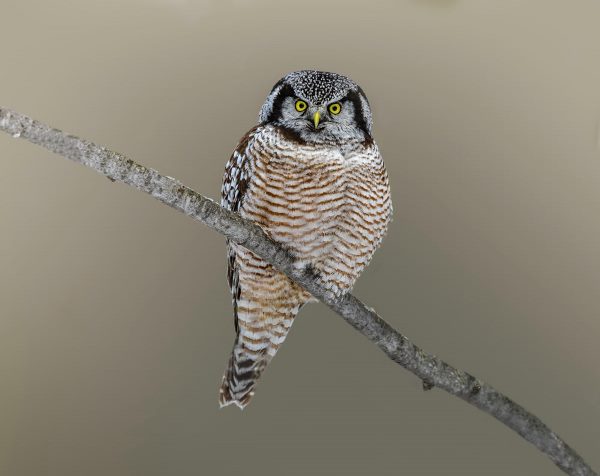
- Scientific name: Strix occidentalis
- Size: 14.2-17.7 inches long
- Weight: 8.5-16 ounces
- Wingspan: 27.9 inches
The Northern Hawk Owl gets its name from the fact that it behaves like a hawk, but it’s actually an owl. They hunt by sight, have a long tails, and perch at the top of trees, much like hawks do. But they have round heads, yellow eyes, and mottled gray, brown, and white bodies. They also have gray faces with a dark border, making them look distinctively owl-like.
For the most part, they hunt during the day, but you might see them looking for food at night in the forests where they make their homes.
These birds live in the interior of Alaska all year long, but they might rarely venture to the coast or the interior passage.
3. Great Gray Owl

- Scientific name: Asio flammeus
- Size: 24-33inches long
- Weight: 24.7-60 ounces
- Wingspan: 53.9-60 inches
Great gray owls are one of the largest owls in the US. They are larger than a Great Horned Owl, but they are a bit lighter. They sit somewhere in size between a goose and a crow.
As the name suggests, they are gray with silver, white, and brown streaks or bars. They have bright yellow eyes surrounded by brown circles, along with a white “X” between their eyes. They lack ear tufts but have a large, round head.
They dislike being near humans or human settlements, so they’re hard to find. They’re also fairly quiet. They don’t make a lot of noise when they fly, and they don’t call out often.
Great Gray Owls live in coniferous forests and hunt small mammals. In Alaska, you’ll find this owl in the interior all year long, and in the inside passage rarely. They don’t usually move their home unless they travel a bit further south or to lower elevations during the cold weather.
4. Barred Owl
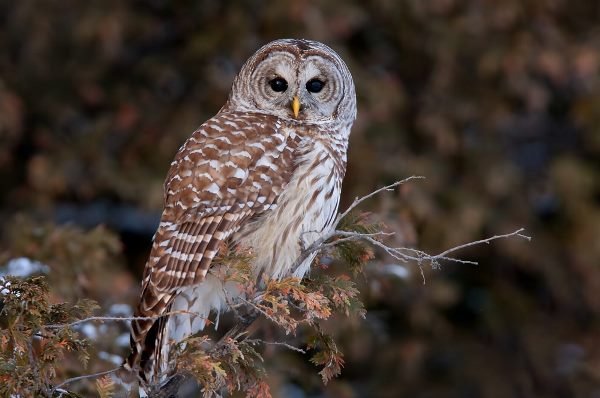
- Scientific name: Strix varia
- Size: 17-20 inches long
- Weight: 16.6-37 ounces
- Wingspan: 39-43 inches
The barred owl is similar in length to the great horned owl, but they weigh much less. They are mottled brown and white with distinct bars across their entire body. The bars on the breasts are vertical and horizontal on the rest of their bodies.
These aren’t noisy birds. They generally keep quiet, though you can hear them call out during the day sometimes.
Barred owls stick to forested areas, whether that’s the swamp or high up a mountain. You won’t find them in cities or prairies. They live across the entire eastern US and up into Canada. In recent decades, the birds have expanded their range, and now there are also populations in the Pacific Northwest.
They don’t migrate during their lives. They just stick to one place, where they make their home in trees. However, if they can’t find food, they will travel long distances to hunt.
Great horned owls hunt the barred owl, while the barred owl is forcing the spotted owl, which is endangered, out of its territory.
Barred owls only live in the southeast inside passage of Alaska. You won’t find them any further north. However, they live there all year long.
5. Western Screech Owl
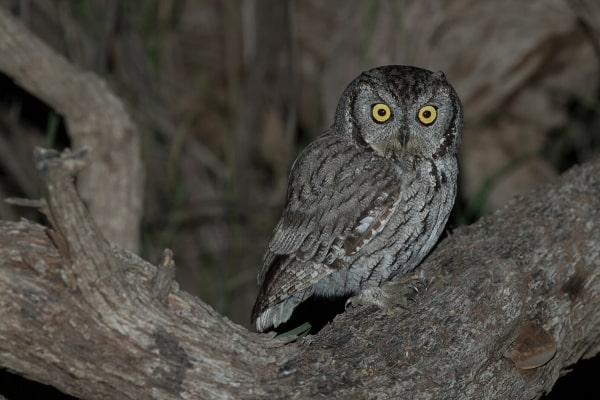
- Scientific name: Otus kennicottii
- Size: 7.5-10 inches long
- Weight: 3.5-11 ounces
- Wingspan: 21.5-24.5 inches
Western screech owls are small, about the size of a robin. But the screech they emit is anything but petite. They’re difficult to identify in the wild because they blend in super well with their environment. If you want to find a screech owl, pull up a seat outside at night and listen carefully.
The base of their body is gray, brown, or red, with a pale breast. Their body is covered in dark streaks that look extremely similar to the bark of many trees. They have yellow eyes and distinct ear tufts in a V-shape.
They’re nocturnal, and they make their home in the holes of trees and cacti, but they’ll also make their home in a nestbox in your backyard if you provide them with one.
They’re common in suburban areas, and they’ll even make their home in urban parks. In Alaska, these petite owls live in across the state, particularly in the southern regions.
While they prefer to eat small rodents, they’re powerful birds and can even pick up a full-grown rabbit.
6. Northern Saw-Whet Owl

- Scientific name: Aegolius acadicus
- Size: 7.1-8.3 inches long
- Weight: 2.5-5.3 ounces
- Wingspan: 16.5-19 inches
Northern saw-whet owls are petite, about the size of a robin, with a mottled brown and white body. They have big yellow eyes and a heart-shaped face with a small, white V-mark between their eyes.
They are difficult to see, especially because they hunt at night, but if you listen for their shrill call, you’ll know they’re nearby. During the day, they nest in cavities in trees at about eye height, so you might see them if you look carefully. Don’t disturb the sleeping birds, though!
They only live in forests, particularly mature forests, so don’t look for them in open areas or cities. They migrate long distances to breed. They eat small rodents like mice and shrews. They’ll also eat birds like chickadees, juncos, waxwings, and sparrows.
They live across the US, with scarce breeding populations in the South and permanent populations in the northern part of the country and throughout the Rocky Mountains and western Coastal ranges. Nonbreeding populations exist across the rest of the country.
The northern saw-whet owl lives in the southern coast and the inside passage of Alaska all year long. They don’t venture any further north into the interior of the state.
7. Short-Eared Owl

- Scientific name: Asio flammeus
- Size: 13.4-17 inches long
- Weight: 7.3-16.9 ounces
- Wingspan: 33.5-40.5 inches
If you guessed that these owls have short ear tufts, you’re right. Owls have ear tufts to help direct sound to their ears, enabling them to hunt and hear potential predators. Short-eared owls have ear tufts, but they’re extremely small, like tiny horns.
They’re distinctive owls because they have brown and white mottling edged in black bars. The face is cream with dark black outlines around the yellow eyes.
Their distinctive appearance makes it easier to spot them, but the fact that they are active during the day makes it even easier to see them. They even have a distinct, moth-like flight pattern that makes identification even simpler.
Unlike many owls, they don’t prefer wooded areas. They like open fields and grasslands, where they sit on the ground and watch and listen for prey to catch. Then, they fly up and dive down to catch their prey. They even nest in the ground.
They live in all of Alaska all year round, but only rarely.
8. Snowy Owl

- Scientific name: Bubo scandiacus
- Size: 20.5-28 inches long
- Weight: 56.5-104 ounces
- Wingspan: 49.5-57 inches
Snowy owls are striking birds. The males are mostly white with bright, cat-like yellow eyes. The females and immature birds have dark brown or black spots. The males become whiter as they age.
Snowy owls live in the Arctic Circle, where they hunt for mammals such as lemming and ptarmigans during the long summer days. They travel south to Canada, Alaska, and the very northern parts of the US during the winter months.
Most of the time, you can see them sitting on the ground near their hunting areas. They’ll also perch on power or telephone poles, fences, and hay bales. They fly low to the ground as they scan the tundra or fields where they hunt for small mammals.
In Alaska, look for these owls in all parts of the state all year long. This is a fairly rare bird to see, especially because their populations are declining, but Alaska has more populations than any other state in the US.
9. Boreal Owl
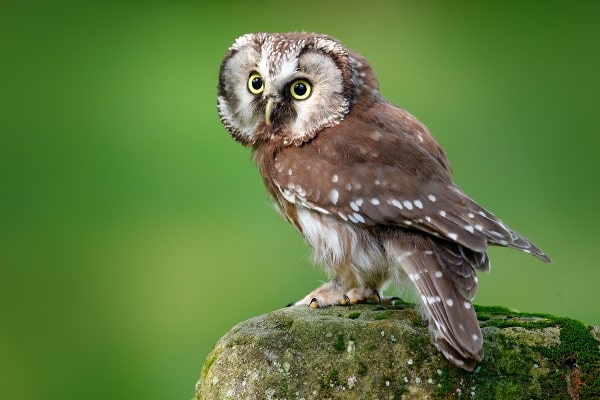
- Scientific name: Aegolius funereus
- Size: 8.3-11 inches long
- Weight: 3.3-7.6 ounces
- Wingspan: 21.5-24.5 inches
Boreal owls live in the eastern passage and the interior of Alaska year-round. They stick around the same general area for their whole life, but they will travel if they can’t find food in their neighborhood. They stick to forests and prefer the high mountains. However, if you live near a mountain or forested area, you can place a nest box in your backyard, and they might come to live.
These owls hunt at night, looking for small mammals. But they don’t fly around actively hunting. Instead, they sit in a tree and patiently wait for a rat or mouse to run across the ground. Then they attack.
Boreal owls are adorable. They’re about the size of a robin, with a large square head. They’re brown overall with white mottling on their bodies and a mostly white face. The females are double the size of the males.
10. Northern Pygmy-Owl
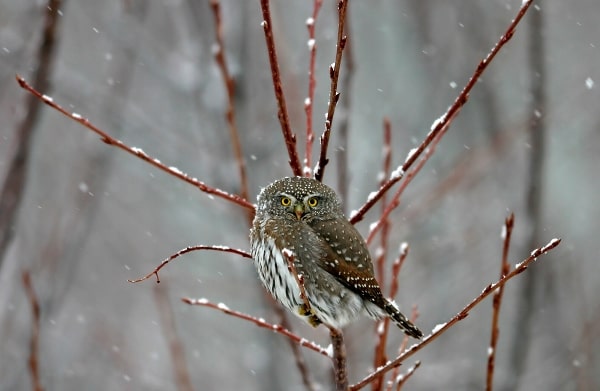
- Scientific name: Glaucidium gnoma
- Size: 6.3-7.1 inches long
- Weight: 2.2-2.5 ounces
- Wingspan: 12 inches
As you might guess from the name, this is a tiny owl. They’re brown overall with small white spots on their head and more prominent white spots on their wings and back. On the back of their neck, they have two spots that resemble eyes to scare away other predators like Great Horned Owls.
They live in forests and nest in conifers, which is why they’re prevalent in the Pacific Northwest and in much of the Rocky Mountains.
Those birds hunting in Alaska can find this petite owl in the inside passage year-round. They also might venture into parts of the southern coast, but only rarely.
They don’t migrate but stay in the same area for their entire lives. They will move to lower elevations during the coldest time of the year.
Like many other owls, they nest in cavities in trees. They don’t make the hole themselves, though. They look for holes left by other animals or natural decay.
Northern pygmy owls eat small birds, lizards, insects, and mammals, but they might even snag themselves a larger bird like a quail. They hunt during the day.
Also Read: Woodpeckers in Alaska
